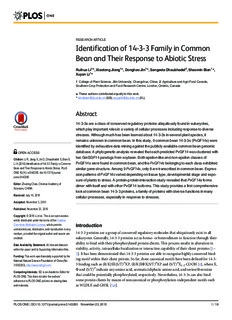
Identification of 14-3-3 Family in Common Bean and Their Response to Abiotic Stress PDF
Preview Identification of 14-3-3 Family in Common Bean and Their Response to Abiotic Stress
RESEARCHARTICLE Identification of 14-3-3 Family in Common Bean and Their Response to Abiotic Stress RuihuaLi1☯,XiaotongJiang1☯,DonghaoJin1☯,SangeetaDhaubhadel2,ShaominBian1*, XuyanLi1* 1 CollegeofPlantScience,JilinUniversity,Changchun,China,2 AgricultureandAgri-FoodCanada, SouthernCropProtectionandFoodResearchCentre,London,Ontario,Canada ☯Theseauthorscontributedequallytothiswork. *[email protected](SB);[email protected](XL) Abstract 14-3-3sareaclassofconservedregulatoryproteinsubiquitouslyfoundineukaryotes, whichplayimportantrolesinavarietyofcellularprocessesincludingresponsetodiverse stresses.Althoughmuchhasbeenlearnedabout14-3-3sinseveralplantspecies,it remainsunknownincommonbean.Inthisstudy,9commonbean14-3-3s(PvGF14s)were identifiedbyexhaustivedataminingagainstthepubliclyavailablecommonbeangenomic OPENACCESS database.AphylogeneticanalysisrevealedthateachpredictedPvGF14wasclusteredwith twoGmSGF14paralogsfromsoybean.Bothepsilon-likeandnon-epsilonclassesof Citation:LiR,JiangX,JinD,DhaubhadelS,BianS, LiX(2015)Identificationof14-3-3FamilyinCommon PvGF14swerefoundincommonbean,andthePvGF14sbelongingtoeachclassexhibited BeanandTheirResponsetoAbioticStress.PLoS similargenestructure.Among9PvGF14s,only8aretranscribedincommonbean.Expres- ONE10(11):e0143280.doi:10.1371/journal. sionpatternsofPvGF14svarieddependingontissuetype,developmentalstageandexpo- pone.0143280 sureofplantstostress.Aprotein-proteininteractionstudyrevealedthatPvGF14aforms Editor:ZhulongChan,ChineseAcademyof dimerwithitselfandwithotherPvGF14isoforms.Thisstudyprovidesafirstcomprehensive Sciences,CHINA lookatcommonbean14-3-3proteins,afamilyofproteinswithdiversefunctionsinmany Received:July15,2015 cellularprocesses,especiallyinresponsetostresses. Accepted:November3,2015 Published:November23,2015 Copyright:©2015Lietal.Thisisanopenaccess articledistributedunderthetermsoftheCreative CommonsAttributionLicense,whichpermits Introduction unrestricteduse,distribution,andreproductioninany 14-3-3proteinsareagroupofconservedregulatorymoleculesthatubiquitouslyexistinall medium,providedtheoriginalauthorandsourceare credited. eukaryotes.Generally,14-3-3proteinsactashomo-orheterodimerstofunctionthroughtheir abilitytobindwiththeirphosphorylatedproteinclients.Thisprocessresultsinalterationin DataAvailabilityStatement:Allrelevantdataare stability,activity,intracellularlocalizationorinteractioncapabilityoftheirclientproteins[1– withinthepaperanditsSupportingInformationfiles. 3].Ithasbeendemonstratedthat14-3-3proteinsareabletorecognizehighlyconservedbind- Funding:Thisworkwasfinanciallysupportedbythe ingmotifwithintheirclientprotein.Sofar,threecanonicalmotifshavebeendefinedfor14-3- NationalNaturalScienceFoundationofChina(No. 3bindingsuchas(R/K)SX(S/T)PXP,(R/R)XFX(S/T)PXPand(S/T)PX -COOH[4],whereX, 31300253),http://www.nsfc.gov.cn/. 1-2 Fand(S/T)Pindicateanyaminoacid,aromatic/aliphaticaminoacid,andserine/threonine CompetingInterests:SDisanAcademicEditorfor thatcouldbepotentiallyphosphorylated,respectively.Nevertheless,14-3-3scanalsobind PLOSONE.Thisdoesnotaltertheauthors' someproteinclientsbymeansofnoncanonicalorphosphorylation-independentmotifssuch adherencetoPLOSONEpoliciesonsharingdata andmaterials. asWLDLEandGHSL[5,6]. PLOSONE|DOI:10.1371/journal.pone.0143280 November23,2015 1/18 CommonBean14-3-3FamilyandAbioticStress Plant14-3-3proteinswereidentifiedconcurrentlyfromArabidopsisthaliana,Hordeumvul- gare,SpinaceaoleraceaandOenotherahookeri[7–9].Sincethen,many14-3-3shavebeeniso- latedandcharacterizedinseveralotherplantspecies[10–17].Todate,manyeffortshavebeen madetoelucidatetherolesof14-3-3sinplantdevelopmentandresponsetoabioticstresses [18–23].Over-expressionorsilencingof14-3-3sinfluencedstresstoleranceinplants.For example,over-expressionofArabidopsisAtGF14λincreaseddroughttoleranceincotton[24], whereassilencingofAtGF14μinArabidopsispromoteddroughttolerance[25].Similarly, over-expressionofTOMATO14-3-3PROTEIN4(TFT4)inArabidopsisincreasedalkaline stressresponse[26],whiletheknock-outofRCI1A/AtGF14ψenhancedtheconstitutivefreez- ingtolerance[27].Additionally,14-3-3sthemselvescanbeaffectedbyabioticstresses.For instance,transcriptionalaccumulationsof14-3-3swerealteredbycold,heat,drought,salinity andnutritiondeficiency[27–31].14-3-3salsointeractwithcomponentsofstresssignaling pathwayssuchasABA-responsiveelementbindingfactors,involvedinABA-dependentsignal- ingpathwayundersalinitystresses[32],H+-ATPase,creatinggradientforstomatalopening [33],SALTOVERLYSENSITIVE2(SOS2)thatmediatesintracellularsodiumionhomeostasis andsalttolerance[34]. Comparedtootherorganisms,plantscontainalargenumberof14-3-3isoforms.Forexam- ple,thereare1314-3-3proteinisoformsinArabidopsis[35],8inrice[16],16insoybean[14], 8infoxtailmillet[36]and10inrubber[15].Theseisoformsareencodedbymulti-genefamily withsmalldifferenceinsequence.However,emergingevidencesindicatedthat14-3-3sexert theirregulatoryfunctionsinanisoform-specificmanner.Ithasbeendemonstratedthat14-3-3 isoformsdisplayeddifferentialsubcellularlocalization,distincttissue-specificand/orinducible expression[14,15,26,37,38],whichimpliedtheirspecificinteractionswithcellularclientsdur- ingdevelopmentalprocessesorinresponsetodiversestresses.Forinstance,soybean14-3-3 isoformsshoweddifferentbindingaffinitytoGmMYB176(anisoflavonoidregulator)[19], whilerice14-3-3isoformsdisplayeddifferentialbindingspecificitytowardsACCsynthase [39].Evidently,14-3-3isoformsplayimportantrolesindeterminingcomplexityandspecificity ofbiologicalfunctionsinplants.Thus,addressingtheimplicationsof14-3-3familydiversity becomesanimportantsteptowardselucidatingtheirrolesinplantdevelopmentalprocesses and/orresistancetostresses. Commonbean(PhaseolusvulgarisL.)isoneofthemostimportantcroplegumesworld- wide.Itisadiploidspecieswith11chromosomes(2n=2x=22)[40],andagenomesizeof473 Mb[41].Althoughmuchhasbeenlearnedabout14-3-3sinseveralplantspecies,no14-3-3has beenidentifiedincommonbean.Availabilityofthewholegenomesequenceofcommonbean facilitatestosystematicallyanalyzegenefamilymembersandtheirpossiblerolesincommon bean.Inthisstudy,dataminingwasconductedagainstpubliclyavailablecommonbeangeno- micdatabase,andatotalof914-3-3s(PvGF14s)wereidentified.ThePvGF14isoformsshowed highsequenceconservationwithSGF14sfromsoybean.Furthermore,PvGF14sdisplayedtis- sue-specificexpressionpatterns,andtheirtranscriptionalactivitieswerealteredwhensub- jectedtocold,droughtandsalinitystress.Thesefindingsprovideafoundationforelucidating therolesofPvGF14sincommonbeanduringdevelopmentorinresponsetoabioticstress. MaterialsandMethods Plantmaterialsandtreatments Commonbean(PhaseolusvulgarisL.)cvDongbeixiaoyoudouisalocalcultivarinthenortheast ofChina.Plants(Dongbeixiaoyoudou)weregrownatexperimentalstationinJilinUniversity (Changchun,JilinProvince,China),in2013,andseedswerecollectedforthefollowing experiments. PLOSONE|DOI:10.1371/journal.pone.0143280 November23,2015 2/18 CommonBean14-3-3FamilyandAbioticStress Seedsofcommonbeancultivar"Dongbeixiaoyoudou"weresurfacesterilizedbyusing10% (w/v)sodiumhypochloritefor20min,andthenwashedthoroughlywithsteriledistilledwater. Thesesterilizedseedswereallowedtogerminatein150mmdiameterplatewithwetfilterpaper understerileconditions.Subsequently,sixwell-germinatedseedswerechosenandsownon eachpotfilledwith65gvermiculite.Alltheseedlingsweregrownundera14hlightand10h darkphotoperiodat25°C(light)and20°C(dark)inachamberandregularlywateredwith Hoaglandliquidmedium.Ten-day-oldseedlingsweresubjectedtothefollowingtreatments andsixpotsofseedlingswereusedforeachtreatment:(1)Forcoldstress,seedlingsweretrans- ferredto4°Candsampleswerecollectedat0,1,3,6,12and24haftercoldtreatment;(2)For droughtstress,watersupplywaswithheldandsampleswerecollectedat0,1,3,5,7and9days ofwaterstress;(3)Forsalinitystress,200mMNaClsolutionwasappliedtoseedlingsandsam- pleswerecollectedat0,3,6,12,33,48and72haftersalttreatment.Theabove-groundparts werecollectedandfrozeninliquidnitrogenandstoredat-80°C. IdentificationofPvGF14sincommonbean Theknown14-3-3proteinsequencesfromsoybean,Arabidopsisandricewereobtainedfrom NCBIdatabase,whichwereusedasqueriestoconductBLASTsearchagainstthepublicgeno- micdatabase(http://phytozome.jgi.doe.gov/pz/portal.html).Theaccessionnumbersof14-3-3 proteinsfromArabidopsis,soybeanandricewerelistedinS1Table.Additionally,toidentify allPvGF14s,akeywordsearchusingtheword"14-3-3"wasconductedagainstthecommon beanwholegenomedatabase(http://phytozome.jgi.doe.gov/pz/portal.html#!search?show= KEYWORD&method=Org_Pvulgaris).AlltheputativePvGF14sweresearchedfor14-3- 3-specificdomainandsignatureusingPROSITE(http://prosite.expasy.org/),Pfam(http:// pfam.xfam.org/search)andSMART(http://smart.embl-heidelberg.de/)programs.Theirsub- cellularlocalizationwaspredictedusingPSORTalgorithmswithdefaultparameters(http:// www.psort.org/). Multiplesequencealignment,phylogenetictreeconstructionandgene structure MultiplesequencealignmentofallputativePvGF14proteinswereperformedbyClustalX,and phylogenetictreeswereconstructedbytheNeighbor-joining(NJ)methodusingMEGA5soft- ware[42].Bootstrapvalueswerecalculatedusing1000replicates.GenestructuresofPvGF14s werebuiltusingSIM4(http://pbil.univ-lyon1.fr/members/duret/cours/inserm210604/ exercise4/sim4.html). CalculationofKa/Ksvalues TheDnaSPprogramversion5.10.1wasusedtocalculatetheratiosofnon-synonymous(Ka) versussynonymous(Ks)substitutionrate(Ka/Ks)fororthologousgenepairsof14-3-3s[43]. Generally,Ka/Ks=1referstoneutralselection,Ka/Ks>1referstopositiveselectiontoacceler- ateevolution,andKa/Ks<1referstopurifyingselectionduringevolution[44]. Chromosomallocalizationandgeneduplication TodeterminethelocationofputativePvGF14sincommonbeanchromosomes,coordinateof individualgeneandchromosomelengthwereobtainedfromPhytozomedatabase.PvGF14sin duplicatedgenomicregionsandKa/KsvaluesforeachduplicatedPvGF14wereretrievedfrom batchdownloadoptionofPlantGenomeDuplicationDatabase(http://chibba.agtec.uga.edu/). Tandemduplicationsweredefinedastwoparalogsseparatedbylessthanfivegenesinthe PLOSONE|DOI:10.1371/journal.pone.0143280 November23,2015 3/18 CommonBean14-3-3FamilyandAbioticStress samechromosome[45],whilesegmentalduplicationsreferredtothosehomologousgenesdis- tributedonduplicatedchromosomalblocksfromthesamegenomelineage. ExpressionanalysisofPvGF14s TotalRNAwasisolatedfromcommonbeantissuesusingRNAprepPurePlantKit(Tiangen Inc,China),accordingtothemanufacture’sinstructionfollowedbyRNase-FreeDNaseI(NEB Inc,NewEngland)treatmenttoremoveDNA.TotalRNA(2μg)wasusedtosynthesizefirst- strandcDNAusingpRimeScriptRTreagentkitwithgDNAEraser(TakaraInc,Japan). RT-PCRwasperformedbyusingthePvGF14gene-specificprimers(S2Table).qPCRwascon- ductedusingABI7500real-timePCRdetectionsystemandSYBRPremixExTaq(TakaraInc, Japan).DatawereanalyzedbyABI7500softwarev.2.0.6,usingACTIN11astheinternalrefer- ence.Theexpressionlevelsofthecontrolsforeachtypeofstresstreatmentsweresetas1,and relativeexpressionlevelofeachPvGF14foreachtreatmentwasnormalizedaccordingly.The primersequencesusedinthestudyarelistedinS3Table.Statisticalsignificanceofthedatawas analyzedbyone-wayANOVAwithLSDtest,andpvalue<0.05wasconsideredtobestatisti- callysignificant. ToanalyzetheexpressionsofPvGF14sindifferenttissues,fragmentsperkilobaseoftran- scriptpermillionmappedreads(FPKM)valuesforeachPvGF14wereextractedfromPhyto- zomedatabasebytrackingcommonbeangene-levelexpression(http://www.phytozome.net). TheheatmapforPvGF14geneswasgeneratedinRusingtheheatmap.2functionfromthe gplotsCRANlibrary(http://CRAN.R-project.org/package=gplots).ToconfirmtheRNA-seq datafromthepublicdatabase,RT-PCRwasperformedbyusingthePvGF14gene-specific primers(S3Table).Forpromoteranalysis,1500bpupstreamregionofthetranscriptionalstart siteofeachPvGF14genewereanalyzedinPlantCAREdatabase(http://bioinformatics.psb. ugent.be/webtools/plantcare/html/). Yeasttwo-hybridassay Toconductyeasttwo-hybrid(Y2H)assay,thegateway-compatiblevectorspGBKT7-DEST andpGADT7-DESTwereutilizedtopreparethebaitandtheprey,respectively[46].Full- lengthPvGF14acDNAwasclonedintopGBKT7-DESTasabaitandself-activationwas checked.Thefull-lengthcDNAsofallPvGF14sexceptPvGF14qwereclonedseparatelyinto thepGADT7-DESTvectoraspreys.Thebaitvectorandeachofthepreyvectorscontaining PvGF14genewereco-transformedintoyeaststrainAH109,andgrownonsyntheticdefined (SD)/-Leu/-Trpselectiveagarmedium.Selectedindividualyeasttransformantsweregrownon liquidmedium,and5μLofyeastsuspensionculturewithaseriesof10Xdilutionswasspotted ontoSD/-Leu/-TrpandSD/-Ade/-His/-Leu/-Trpplates,andgrownfor5daysat30°C.Empty vectorswereco-transformedasnegativecontrols. Results Identificationofcommonbean14-3-3genefamily Toidentify14-3-3proteingenesincommonbean,14-3-3proteinsequencesfromsoybean, ArabidopsisandricewereusedasqueriestoconductBLASTsearchagainstthecommonbean genomicdatabase(http://www.phytozome.net/).Inaddition,akeywordsearchusingtheword ‘14-3-3’wasalsoconductedagainsttheabovedatabase.Thisprocessidentifiedatotalof9puta- tive14-3-3genes(PvGF14a-PvGF14e,PvGF14g,PvGF14h,PvGF14nandPvGF14q),which werenamedintermof14-3-3nomenclatureinsoybean.Table1providesdetailinformation onallputativePvGF14s.Thededuced14-3-3proteinscontain248to263aminoacidsresidues PLOSONE|DOI:10.1371/journal.pone.0143280 November23,2015 4/18 CommonBean14-3-3FamilyandAbioticStress Table1. CharacteristicsofPvGF14sgenesincommonbean. Gene Locusname Chromosomallocationa Protein Predicted CorrespondingESTc name subcellularlocationb aa Mw pI (kDa) PvGF14n Phvul.005G066600 Chr05:10288469–10295349 263 30.21 4.75 Cyto,chl,per CV539470 (+strand) PvGF14d Phvul.005G095500 Chr05:28501915–28505383 261 29.56 4.71 Cyto,chl,per GW892341 (+strand) PvGF14c Phvul.002G238300 Chr02:40393090..40396629 258 29.25 4.77 Cyto,chl,per CV530328 (-strand) PvGF14q Phvul.002g102500 Chr02:20470454..20474678 258 29.45 4.75 Cyto,mito,per none (-strand) PvGF14e Phvul.003G043200 Chr03:4827912..4831544(-strand) 259 29.51 4.83 Cyto,chl,per HS103842 PvGF14b Phvul.009G143400 Chr09:20974074..20976460 248 28.19 4.85 Cyto,chl,per FE704892 (-strand) PvGF14a Phvul.008G004300 Chr08:482680..485463(-strand) 256 28.98 4.59 Cyto,chl,per CV530850 PvGF14g Phvul.008G162500 Chr08:41741118..41743699 261 29.30 4.57 Cyto,chl,per GW901700 (+strand) PvGF14h Phvul.009G032500 Chr09:7120999..7123241(+strand) 259 29.16 4.56 Cyto,chl,per GW904281 aChromosomallocationindicatesthepositionofeachgeneinchromosome bcyto,chl,mitoandperrefertocytoplasm,chloroplast,mitochondrialandperoxisome,respectively cEST(ExpressedSequenceTags)accessionwiththehighesthomologytocorrespondingPvGF14gene;aa,aminoacid;pI,isoelectricpoint;Mw, molecularweight. doi:10.1371/journal.pone.0143280.t001 withthecalculatedmolecularweightsfrom28.19to30.21kDa,andtheestimatedisoelectric pointsfrom4.56to4.85.AsshowninFig1,allthepredictedPvGF14scontaina14-3-3con- serveddomainfeaturedbyoneortwo14-3-3proteinsignatures,andtheywerepredictedto localizeincytoplasm,peroxisome,chloroplastand/ormitochondria(Table1). AnalignmentofdeducedaminoacidsequencesofPvGF14switheachotherindicatedthat theisoformsexhibithighsequenceconservationwiththeidentityrangingfrom63.0%to94.2% ataminoacidlevel(Fig1andS4Table).Thesequencediversificationmainlyoccurredatthe N-terminalandtheC-terminalregions,suggestingthatthoseregionsarepossiblyresponsible forisoformspecificity[47].Additionally,sequenceconservationataminoacidlevel(57.6%to 96.9%)wasalsoobservedbetweensoybeanandcommonbean14-3-3proteins.EachPvGF14 showedmorethan92%sequenceidentitywithitsorthologsinsoybean(S5Table). Evolutionaryrelationshipandgenestructureof14-3-3genefamilyin commonbean Toexaminetheevolutionaryrelationshipof14-3-3proteinsfromcommonbeanandother plantspecies(soybean,Arabidopsisandrice),aphylogeneticanalysiswasconductedatboth nucleotideandproteinlevels.Inboththecases,treeswithsimilartopologieswereobtained (Fig2).PvGF14n,PvGF14d,PvGF14c,PvGF14eandPvGF14qwereclusteredintotheepsilon- likeclass,whilePvGF14a,PvGF14g,PvGF14handPvGF14bweregroupedtogetherwithnon- epsilonisoformsof14-3-3proteinsfromArabidopsis,riceandsoybean.EachPvGF14was clusteredtogetherwithtwoGmSGF14orthologs(Fig2andS5Table).Theanalysisrevealed thatPvGF14sareevolutionarilyclosertosoybean14-3-3scomparedtoArabidopsisandrice, whichisconsistentwiththespeciesevolutionaryhistory[40].The14-3-3sfromArabidopsis andriceformedseparatecladesorbranchesinthephylogenetictreesuchasAtGF14pi, PLOSONE|DOI:10.1371/journal.pone.0143280 November23,2015 5/18 CommonBean14-3-3FamilyandAbioticStress Fig1.SequencealignmentofcandidatePvGF14proteins.Identicalaminoacidresiduesareshowninblack.Theα-helixsofPvGF14sareshownasaline and14-3-3signaturesofPvGF14sareshowninrectangularboxes. doi:10.1371/journal.pone.0143280.g001 AtGF14epsilon,AtGF14omicronandOsGF14h(Fig2),suggestingthattheseepsilon-like14-3- 3geneswerelostincommonbeanandsoybeanduringevolutionorevolvedanewfunction. Tobetterunderstandtheevolutionaryrelationshipbetween14-3-3s,theratiosofKa/Ksfor 14-3-3pairsfromcommonbean,soybean,Arabidopsisandricewereestimated(S6Table).As aresult,theKa/Ksvaluesrangedfrom0to0.347withanaverageof0.083.Allthe14-3-3s appeartobeunderpurifyingselectionduringevolution,astheirKa/Ksratioswereestimated <1.SinceeachofPvGF14sanditstwoclosely-relatedorthologsinsoybeanwereclusteredinto samediscretecladeinthephylogenetictree,theKa/Ksratioswerefurtherobserved.TheKa/Ks ratiosfortheclosestorthologpairsvariedfrom0to0.153withanaverageof0.060,suggesting thattheorthologpairsamonglegumestendtohavelessevolutionarydiversification. Toinvestigatetheexon-intronorganizationinPvGF14s,genestructuresweremappedon thebasisofthegenomicandcodingregionsequences.Commonbean14-3-3genestructure comprisedof4exonsinnon-epsilonclass,and6–7exonsinepsilon-likeclass(Fig3).The PLOSONE|DOI:10.1371/journal.pone.0143280 November23,2015 6/18 CommonBean14-3-3FamilyandAbioticStress Fig2.PhylogeneticanalysisofPvGF14sandotherGF14sfromdifferentspecies.PhylogenetictreeswerecalculatedbasedonCDSmatrix(A)and proteinmatrix(B)fromcommonbean(PvGF14),soybean(GmSGF14),Arabidopsis(AtGF14)andrice(OsG14F),andthetreewasclassifiedintoepsilon andnon-epsilongroups.EachPvGF14/PvGF14isindicatedbyastar. doi:10.1371/journal.pone.0143280.g002 PLOSONE|DOI:10.1371/journal.pone.0143280 November23,2015 7/18 CommonBean14-3-3FamilyandAbioticStress Fig3.GenestructuresandchromosomallocalizationofPvGF14sincommonbean.TheleftpanelisthephylogenetictreeofPvGF14s;themiddlepanel istheintron-exonstructureswheretheexonsareshownbyrectangular,andtheintronsarerepresentedbythinlines;therightpaneldisplaysthe chromosomallocalizationofPvGF14s. doi:10.1371/journal.pone.0143280.g003 PvGF14sbelongingtothesameclasscontainedsimilarsizeofexons,suchasPvGF14qand PvGF14e,PvGF14nandPvGF14d,PvGF14gandPvGF14h(Figs2and3).Evidently,conserved genestructureofPvGF14sstronglysupportsthereliabilityofphylogenetictree. Chromosomaldistributionandduplicationsof14-3-3sincommonbean TheninePvGF14sarelocatedonfivedifferentchromosomes(chromosomes2,3,5,8and9)in commonbean.EachchromosomecontainstwoPvGF14sexceptchromosome3(Fig3).Gene familycanarisefromthesegmentalduplicationortandemamplificationofchromosomal regions[48].Generally,tandemamplificationwasdefinedastwoparalogsseparatedbyless thanfivegenesinthesamechromosome.ThePvGF14sinthesamechromosomeweredistrib- utedfarfromeachother(Table1andFig3),suggestingthatcommonbean14-3-3genefamily waslikelyderivedfromsegmentalduplicationratherthantandemamplificationofchromo- somalregions.Furthermore,weinvestigatedwhethertraceablegenomeduplicationscontribu- tetotheexpansionofthe14-3-3genefamilyincommonbean.Theresultsrevealedthatthesets ofPvGF14s(PvGF14candPvGF14d,PvGF14qandPvGF14e)weremappedontheduplicated block120andblock93,respectively,suggestingthatthesetwopairswerepossiblyderivedfrom segmentalduplicationeventsduringtheevolutionaryprocess.Notraceableduplicationevent PLOSONE|DOI:10.1371/journal.pone.0143280 November23,2015 8/18 CommonBean14-3-3FamilyandAbioticStress Fig4.ExpressionanalysisofPvGF14genesinvarioustissues.Thetranscriptomedataofcommonbeanacrossdifferenttissuesanddevelopmental stageswereextractedfromthepublicly-availablePhytozomedatabase(http://www.phytozome.net)forheatmapgeneration.Thecolorscaleabovetheheat mapindicatesgeneexpressionlevels,lowtranscriptabundanceindicatedbygreencolorandhightranscriptabundanceindicatedbyredcolor.Maximum FPKMvalueforeachPvGF14isshown. doi:10.1371/journal.pone.0143280.g004 wasobservedforotherPvGF14s.ToinvestigatetheselectiveevolutionarypressureonPvGF14 genedivergenceafterduplication,thenon-synonymous/synonymoussubstitutionratio(Ka/ Ks)wasretrievedforthetwoduplicationpairsof14-3-3genes.Consequently,Ka/Ksvalueof thegeneduplicationpairs,PvGF14candPvGF14daswellasPvGF14qandPvGF14ewere0.058 and0.073,respectively,suggestingthatthesegenespossiblyhaveundergoneapurifyingselec- tionwithlimitedfunctionaldivergenceafterduplication. ExpressionanalysisofPvGF14sincommonbeantissues ToinvestigateexpressionpatternsofPvGF14s,weutilizedthepubliclyavailablegenome-wide transcriptprofilingdataofcommonbeantissuesfromPhytozomedatabase(http://www. phytozome.net),whichcontainsRNAseqreadsfromvegetativetissues(trifoliates,nodule, root,stem,leaf)andproductivetissues(flowerbud,flower,pod).Allthecommonbean14-3-3 genesshowedtissue-specificexpressionpatterns(S7Table).Overall,PvGF14transcriptscan becategorizedinto3groupsbasedontheirexpressionpatterns(Fig4).Group1comprisedof PvGF14g,PvGF14handPvGF14a,whichweremainlyexpressedinstems,flowerbudsand/or root_10.Group2containedPvGF14d,PvGF14candPvGF14bwithhighexpressioninflowers, flowerbuds,stemsand/orpods,whilegroup3consistedofPvGF14n,PvGF14eandPvGF14q withtranscriptabundanceeitherinstemsorrootsorflowerbuds.Also,fourrepresentative PLOSONE|DOI:10.1371/journal.pone.0143280 November23,2015 9/18 CommonBean14-3-3FamilyandAbioticStress PvGF14s(PvGF14candPvGF14dfromepsilon-likeclass,PvGF14aandPvGF14bfromnon- epsilonclass),werechosentoconfirmthepubliclyavailabletranscriptprofilingdatausing RT-PCRapproach,andsimilarexpressionpatternswereobservedinstem,leaf,flowerandpod ofcommonbean(S1Fig). Themaximumfragmentsperkilobaseoftranscriptpermillionmappedreads(FPKM)for PvGF14qwaslow(3.69)comparedtothereadsforotherPvGF14s(40.02to593.92).Addition- ally,blastsearchagainstExpressedSequenceTags(ESTs)inNCBIdatabasedidnotfindany ESTcorrespondingtoPvGF14q(Table1).OurattemptstoamplifyPvGF14susingcDNAsyn- thesizedfromRNAisolatedfromseveraldifferenttissuesofcommonbeanyieldedsuccessful resultsforallthePvGF14sexceptPvGF14q.Theseresultsindicatedthatcommonbeancontain only8putative14-3-3genesthataretranscribed. EffectofabioticstressesontheexpressionofPvGF14s Severalstudieshavedocumentedaroleofplant14-3-3proteinsinabioticstressresponse[24– 31].ToinvestigateifPvGF14salsohavesimilarrolesincommonbean,weexaminedthe expressionpatternsofPvGF14sinresponsetocold,droughtandsalinitystress. Ten-day-oldcommonbeanseedlingswereexposedtocoldstressat4°Cfor0,1,3,6,12or 24h,andexpressionofPvGF14sweremonitored.Theresultsrevealedthatcoldstressaltered theexpressionsofPvGF14sthatcouldbegroupedinto2categories.AsindicatedinFig5A,cat- egory1containedgenesthatshowedgradualincreaseintranscriptaccumulationasthestress prolonged.Forexample,PvGF14n,PvGF14d,PvGF14e,PvGF14gandPvGF14htranscriptlevels increasedto1.9,2.1,2.6,2.8and1.8fold,respectivelyascomparedtocontrol.Allthesefive genefamilymemberswereexpressedtotheirhighestleveleitherat12or24haftercoldstress. Thecategory2comprisedthegenes(PvGF14a,PvGF14bandPvGF14c)whosetranscriptlevels increasedwithcoldstresstreatmentfollowedbygradualdecreaseasthestresscontinued. PvGF14candPvGF14atranscriptsreachedtotheirmaximumlevelat12hcoldstresswith3.58 and1.85foldincrease,respectivelyascomparedtocontrol,whilePvGF14bwasexpressedto thehighestlevelat3hwith3.73foldincreaseascomparedtocontrol. Whencommonbeanseedlingswereexposedtodroughtstress,theexpressionofPvGF14e, PvGF14gandPvGF14hwasdecreasedto5.3,13.0and2.9foldon9,7and5daysaftertreatment, respectively(Fig5B).Onthecontrary,adistinctincreaseintranscriptaccumulationon9days ofdroughttreatmentwasobservedforPvGF14nandPvGF14cwith2.82and1.86foldchanges, respectively.AdramaticincreaseinPvGF14atranscript(5.32fold)ascomparedtocontrolwas observedon5daysofdroughttreatment. Whenyoungseedlingsweresubjectedtosaltstress,theexpressionsofPvGF14n,PvGF14e, PvGF14gandPvGF14hweregraduallydecreasedasthesaltstressdurationincreased,andtheir maximumfoldchangeswereupto3.54,1.97,1.83and1.67,respectively(Fig5C).Onthecon- trary,theexpressionsofPvGF14d,PvGF14bandPvGF14awerepronouncedatoneormore stresstimepointsby1.54,1.42and1.47fold,respectivelyascomparedtonon-salinitycontrol. PvGF14qtranscriptwasnotdetectedforanyofthestresstreatmentusedinthisstudy. TobetterunderstandtheroleofPvGF14sinabioticstressresponse,promoteranalysiswas alsoconducted.ItwaspredictedthatpromoterregionsofPvGF14eandPvGF14gcontainLTR cis-actingelementinvolvedinlow-temperatureresponsiveness,supporting2.6and2.8fold increaseintheexpressionofPvGF14eandPvGF14gundercoldstress.PvGF14q,PvGF14nand PvGF14dcontainABREcis-actingelementintheirpromoter,whichisimplicatedinABA response.HSE,acis-actingelementrelatedtoheatstressresponse,wasfoundinthepromoters ofPvGF14q,PvGF14c,PvGF14n,PvGF14gandPvGF14h.Allthe14-3-3genesexceptPvGF14c containTC-richrepeat,acis-actingelementinvolvedindefenseandstressresponse.In PLOSONE|DOI:10.1371/journal.pone.0143280 November23,2015 10/18
Description: